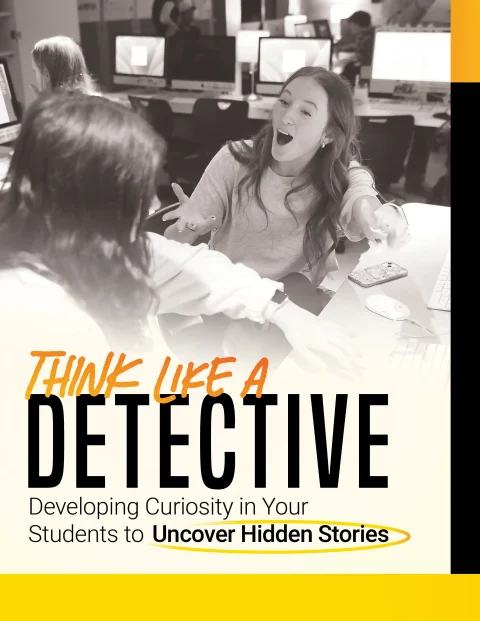There’s no question on the planet that better captures what it means to be curious than “why?” Why does the camera refuse to focus? Why does the volleyball team perform a chant before every game? Why do the drummers wear funny hats during a concert? Why does my teacher have a life-size cutout of Steve Irwin in the corner of their classroom? Why did everyone start baking sourdough bread during the pandemic? Why, why, why? The best question any good detective, teacher, student or reporter could ask is, “Why?” And yet, every year, I still have to teach my staff the basics of what it means to be curious.
A healthy dose of curiosity can be the spark that drives coverage, so as an adviser, it’s crucial that we find creative ways to ignite and foster curiosity daily. I spend a week training my staff how to think like a detective and channel their inner five-year-olds’ sense of curiosity for us to start building our coverage. If you find yourself wondering where to start, let me tell you, it’s not as complicated as you may think – just remember PPT: people, places and things.
PEOPLE
Every year, we aim to ensure every student receives coverage in the book more than once, and every year, we get increasingly closer to making it happen. Where we fall short is often with the students who move in or out of the district or don’t take a full load of classes on campus.
From day one, I tell my staff people are the heart and soul of a yearbook. Their stories, experiences, successes and failures play a part in the tapestry we weave into the book. If we don’t know our people or aren’t paying attention, we miss yearbook-worthy stories happening around us all the time.
My best example of this was a story about a student named Mabele, a refugee from the Congo, Africa. Mabele was an incredibly quiet and shy student. He rarely talked in class, didn’t participate in any school activities and often showed up late to class. We would have never stumbled upon his story had my reporter Sydney Lyman failed to take notice of one small thing: tardies. Every day, Mabele would show up to class 10-15 minutes late, and the teacher would never mark him tardy. This prompted her to ask the teacher why (in the most respectful way), and the teacher explained that Mabele came late from his job and had prior approval. Naturally, her interest piqued, and she quickly brought this to the editor’s attention.
Sydney knew she had to approach Mabele respectfully because he might not want to share his story, so I coached her through the next steps. What she uncovered next changed all of our perspectives.
Mabele’s entire life turned upside down the day a local militia started raiding homes in his neighborhood, killing everyone in their path. He took off running with other refugees and ended up in Uganda, stuck in a refugee camp at the tender age of seven. Not knowing whether his family was alive or dead, he fought for years to leave Uganda and eventually found himself in Spokane, Washington, in 2018. When I tell you
the power of his story brought us all to tears, I mean it touched every one
of my staff members.
Paying attention to people has led to my students uncovering some of their best stories. It doesn’t matter how obscure, weird or small a clue they pick up on. If someone shows up to class 20 minutes late, ask why. If you see a freshman decked out from head to toe in custom spirit gear, find out why. It’s our job to keep our heads on a swivel 24/7 and take notice. We spend a great deal of time talking about what it means to be aware, vigilant and observant. I want my staff to be thinking about yearbook-worthy stories during every class they take, game they show up to or event they photograph.
PLACES
Sometimes, your surroundings can be the easiest places to find inspiration. Whether your school is going through a remodel or in desperate need of one, there could be stories lurking just around the corner.
One of my favorite spreads my staff created almost didn’t happen. An editor proposed a page on classroom clutter, and I immediately said, “Why?” They explained a lot of teachers had weird decorations and clutter in their rooms that students would fixate on while bored in class. The next thing I know, we’ve got a crochet granny sweater and wig, a taxidermy baby deer, a mannequin foot and a “Teb-o-meter” poster showing up in my classroom. I knew immediately they were onto something. We paired those items with a matching game for funny, interesting and engaging coverage.
My students also started to dig into our lunchroom. Why do students sit in certain places? Why does so-and-so have to sit in the same spot every single day? Why do we not have enough tables or chairs for everyone? Why, why, why?
So often, I tell my students to pay attention to the places they go to and find one thing that catches their attention. You never know what you might stumble upon in the spaces you visit daily.
THINGS
This one is easy, and often, my students become so good at paying attention to the little things that we have too much content coming at us. Things can be anything from keychains to nail art, clothing items, food, etc.
At the beginning of the year, I send my students on a daily scavenger hunt where they have to find one thing that stands out to them and take a photo of it to share with the class. It could be a sticker on a water bottle, a clothing item, food, drinks or activities in class that use unusual tools/equipment/etc. We have generated entire spreads based on some of these items because we noticed a trend or felt like so many shared stories connected with that “thing” deserved coverage.
Things are everywhere – sports games, concerts, plays, competitions, in backpacks and worn to school daily. Sometimes, those little things can spark bigger ideas –you just have to start by teaching your students to pay attention to them. Turning it into a game of show-and-tell is one of the easiest ways to have students engage with the idea of being a detective. However, it takes constant awareness and curiosity to get there.
Developing their sense of curiosity is by far the most fun and rewarding part of teaching students to be journalists. With every new story they uncover, students gain more confidence, especially when
it comes from an unexpected source.
As you start to plan your coverage, I encourage you to push your students to embrace that inner five-year-old that lives in all of us and question the world around them. Ask why, keep your head on a swivel and pay attention to the people, places and things around you. You never know what treasure trove of stories is waiting to be uncovered.





